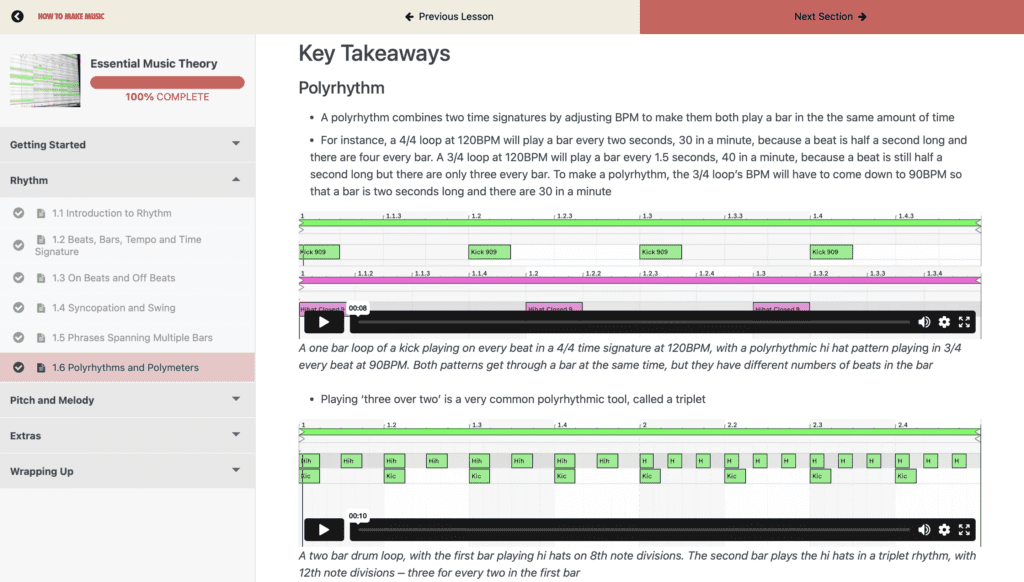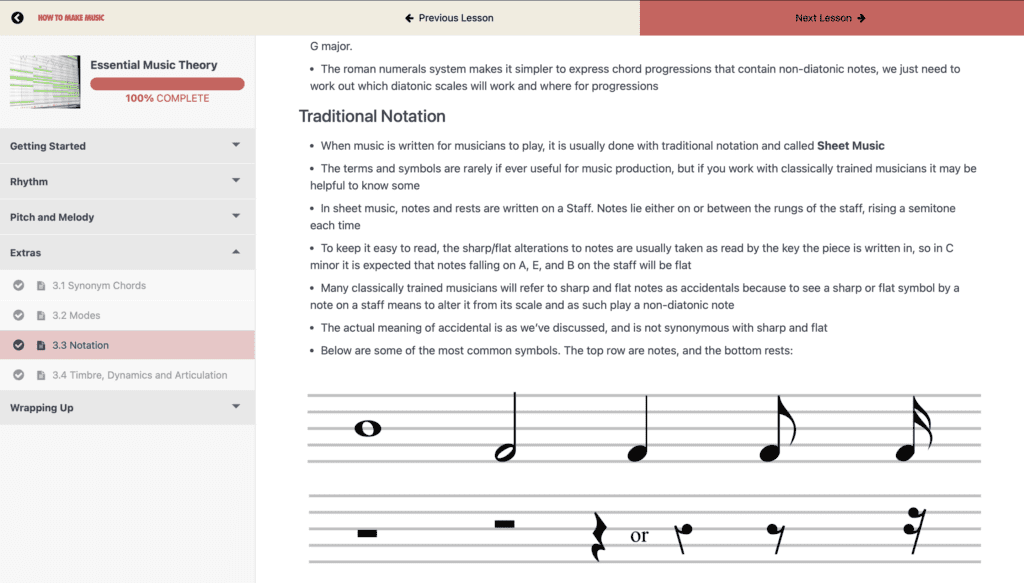The ideal guide to making better music for electronic musicians — without the pop songs and nursery rhymes!
LIMITED TIME OVER 50% OFF SALE! Get immediate lifetime access with a single payment of £99 £39, or pay in interest-free instalments with Klarna!
At a certain point, we all come to realise that no matter how crisp and clear we can make a mix, no matter how deep and complex our sound design, our music is just boring without an emotionally captivating melodic structure.
Essential Music Theory is the one-stop destination that will give you the skills and confidence to make music that just works. Music theory isn’t boring and it isn’t a set of rules; music theory is an observation of how sounds turn into music and affect our emotions, and becoming aware of the ways in which we can create satisfying music is fundamental to creating music that we’ll enjoy making and others will enjoy listening to!
A clip from the ‘Beats, Bars, Tempo and Time Signature’ lesson in the Rhythm section of the course
Who is This Course For?
Essential Music Theory is optimised for modern music producers, beat makers, and electronic musicians that want to know how to make things work without the fluff of learning nursery rhymes and dated pop songs!
If you find yourself just hitting keys on a keyboard and hoping for the best, or dragging drums around a grid until something hits you, Essential Music Theory will be absolutely invaluable.
If you know the basics but want to take the next step into understanding how to move from chord to chord in a satisfying way, how polyrhythms work, and how all the rules you thought you knew can be broken to make the most interesting and captivating music, Essential Music Theory has you covered.
A clip from the ‘Chords’ lesson in the Pitch and Melody section of the course
How Does it Work?
There’s about two and a half hours of video in Essential Music Theory, but this is so much more than just a ‘video course’. Every single concept of music theory from basic to advanced is broken down into simple to follow guides, with no prior knowledge assumed and nothing left to the imagination.
Don’t you hate watching a tutorial and then having to try and figure out where in the long video the part you want to revisit or follow along with is? Us too, which is why every single step in Essential Music Theory is delivered within an expertly developed learning environment, with audio, video, and bulleted Key Takeaways below the main video. Want to check how to develop a specific chord progression? No need to scan through a long video, just go to the short and snappy lesson and find the exact part you’re looking for ready to play and replay below the main lesson video.
What You'll Learn
Rhythm
We’ll kick off with a look at rhythm, from the most basic understanding of what rhythm is all the way to complicated combinations of different time signatures and rhythmic bases. Every section has a main lesson video plus all the Key Takeaways:
- Introduction to Rhythm
- Beats, Bars, Tempo and Time Signature
- On beats and off beats
- Syncopation and Swing
- Phrases Spanning Multiple Bars
- Polyrhythms and Polymeters

Pitch and Melody
- Introduction to Pitch and Melody
- Pitch
- Introduction to Scales
- Scale Degrees and Intervals
- Motifs
- Chords
- More Complicated Chords
- Chord Quality, Implied and Suspended Chords
- The Circle of Fifths
- Consonance, Dissonance, Tension and Resolution
- Progression
- Cadences
- An Important Connection: Harmonic Minor
- Non-Diatonic Notes
- Popular Chord Progressions
- Fundamental Techniques for Harmonising


Extras
We’ll wrap up with the importance of some advanced concepts and use our newfound knowledge to understand them, as well as explore various methods of notation and consider how we can make more interesting music by considering sound as more than just pitch and rhythm. Every section has a main lesson video plus all the key takeaways:
- Synonym Chords
- Modes
- Notation
- Timbre, Dynamics, and Articulation

A single payment of £99, or pay in interest free instalments with Klarna!
